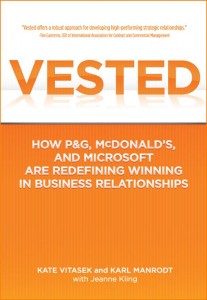 The latest Vested book released this month, Vested: How P&G, McDonald’s and Microsoft are Redefining Winning in Business Relationships, examines how real-life, real-time companies use the Vested approach of collaboration, creating and sharing value, trust and innovation to achieve amazing long-term success.
The latest Vested book released this month, Vested: How P&G, McDonald’s and Microsoft are Redefining Winning in Business Relationships, examines how real-life, real-time companies use the Vested approach of collaboration, creating and sharing value, trust and innovation to achieve amazing long-term success.
But this win-win formula is not just for the big companies named in the title. Vested works for organizations large and small, commercial, government and even non-profit organizations.
One of my favorite success stories featured in the book is from the innovative non-profit Water for People. Water for People, based in Denver, helps people in developing countries improve their quality of life by supporting the development of locally sustainable drinking water resources, sanitation facilities, and hygiene education programs. It was founded in February 1991 by Ken Miller, an executive with CH2M HILL and former president of the American Water Works Association (AWWA), the authoritative resource on safe water in North America and beyond; Wayne Weiss, vice president of Black & Veatch International, an infrastructure development firm; and John B. Mannion, a former executive director of AWWA.
All three believe that clean water is a basic human right. Of course, most if not all NGOs such as Water for People bring passion, beliefs and commitment to the table, but what sets Water For People apart is its Vested approach to following the Five Rules for working with partners to help to make the passion and vision a reality. A focus on long-term sustainable solutions means Water For People starts with alliances that are long-term and sustainable. Thus it relies on highly Vested commitments from the local communities it enters. For example, the focus is on outcomes—Vested Rule No. 1—not transactions: success comes not just from getting people access to water but by building communities that can sustain their water supply.
It’s not about throwing money and equipment at a problem—in this case access to water. It’s about establishing Vested partnerships with local governments and communities, partnerships that maximize the partners’ ability to solve their own water poverty challenges through creative water and sanitation investments—by focusing on what needs to be done (Rule No. 2).
All of the other Vested rules are displayed in the way the Water for People operational model handles defined and measurable outcomes (Rule No. 3), its pricing models (Rule No. 4), and its governance framework (Rule No. 5).
This inspiring story of Vesting for success and redefining the long-term win-win for something as basic and necessary as water is told in Chapter 7 of Vested—which you can order through this link.
Vested principles work—no matter what industry you are in or how large your organization is.